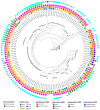Epidemiological Data and Antimicrobial Resistance of Campylobacter spp. in Portugal from 13 Years of Surveillance
- PMID: 38392885
- PMCID: PMC10893263
- DOI: 10.3390/pathogens13020147
Epidemiological Data and Antimicrobial Resistance of Campylobacter spp. in Portugal from 13 Years of Surveillance
Abstract
This study extensively analyzed campylobacteriosis surveillance in Portugal from 2009 to 2021, aiming to investigate demographic shifts, seasonal variations, and antimicrobial resistance (AMR) within Campylobacter isolates. Surveillance network and sentinel laboratory-based system data revealed a substantial under-notification of campylobacteriosis cases, suggesting an underestimated disease burden. Notification rates exhibited a paradigm shift, with a notable prevalence among the pediatric population, particularly in children aged 1-4 years, diverging from European reports. Additionally, an emerging trend of Campylobacter infections in younger adults (15-44 years) was observed. The study unveiled a unique seasonal distribution of cases, defying typical summer peaks seen elsewhere. AMR analysis revealed high resistance to ciprofloxacin and tetracycline, in both C. jejuni (93.7% and 79.2%, respectively) and C. coli (96.5% and 93.2%, respectively), stable throughout the studied period (2013-2021). C. coli exhibited significantly higher resistance to erythromycin, gentamicin, ampicillin and ertapenem compared to C. jejuni (p < 0.001). Multilocus Sequence Typing (MLST) data demonstrated the distribution of resistance markers across diverse sequence types, challenging the notion of a clonal origin for multidrug-resistant isolates. In conclusion, the study highlights the need for enhanced surveillance and raises concerns about alarming AMR levels, recommending the implementation of whole-genome sequencing (WGS)-based surveillance for a deeper comprehension of disease patterns and an evolving AMR landscape.
Keywords: Campylobacter infection; WGS; antibiotic resistance; epidemiology; notification; resistance genetic determinants; surveillance.
Conflict of interest statement
The authors declare no conflicts of interest.
Figures






Similar articles
-
Enhanced laboratory surveillance study of Campylobacter species in England.J Med Microbiol. 2025 Jun;74(6):002017. doi: 10.1099/jmm.0.002017. J Med Microbiol. 2025. PMID: 40504133 Free PMC article.
-
Campylobacter species prevalence, characterisation of antimicrobial resistance and analysis of whole-genome sequence of isolates from livestock and humans, Latvia, 2008 to 2016.Euro Surveill. 2019 Aug;24(31):1800357. doi: 10.2807/1560-7917.ES.2019.24.31.1800357. Euro Surveill. 2019. PMID: 31387670 Free PMC article.
-
Genomic Screening of Antimicrobial Resistance Markers in UK and US Campylobacter Isolates Highlights Stability of Resistance over an 18-Year Period.Antimicrob Agents Chemother. 2022 May 17;66(5):e0168721. doi: 10.1128/aac.01687-21. Epub 2022 Apr 11. Antimicrob Agents Chemother. 2022. PMID: 35404076 Free PMC article.
-
Prevalence of Campylobacter species in human, animal and food of animal origin and their antimicrobial susceptibility in Ethiopia: a systematic review and meta-analysis.Ann Clin Microbiol Antimicrob. 2020 Dec 10;19(1):61. doi: 10.1186/s12941-020-00405-8. Ann Clin Microbiol Antimicrob. 2020. PMID: 33302968 Free PMC article.
-
The worldwide trend of Campylobacter spp., infection from duck-related isolates and associated phenotypic and genotypic antibiotic resistance, since 1985: identifying opportunities and challenges for prevention and control.Poult Sci. 2021 Aug;100(8):101213. doi: 10.1016/j.psj.2021.101213. Epub 2021 Apr 23. Poult Sci. 2021. PMID: 34237548 Free PMC article. Review.
Cited by
-
A Decade of Antimicrobial Resistance in Human and Animal Campylobacter spp. Isolates.Antibiotics (Basel). 2024 Sep 21;13(9):904. doi: 10.3390/antibiotics13090904. Antibiotics (Basel). 2024. PMID: 39335077 Free PMC article. Review.
-
The Impact of Antibiotic Resistance in Childhood Campylobacter Infections Before and After the COVID-19 Pandemic in the Southeast Region of Romania.Antibiotics (Basel). 2025 Feb 10;14(2):170. doi: 10.3390/antibiotics14020170. Antibiotics (Basel). 2025. PMID: 40001414 Free PMC article.
References
-
- European Centre for Disease Prevention and Control (ECDC) Annual Epidemiological Report for 2021. ECDC; Stockholm, Sweden: 2022. Campylobacteriosis.
-
- Rivera-Mendoza D., Martínez-Flores I., Santamaría R.I., Lozano L., Bustamante V.H., Pérez-Morales D. Genomic Analysis Reveals the Genetic Determinants Associated With Antibiotic Resistance in the Zoonotic Pathogen Campylobacter spp. Distributed Globally. Front. Microbiol. 2020;11:513070. doi: 10.3389/fmicb.2020.513070. - DOI - PMC - PubMed
MeSH terms
Substances
Grants and funding
LinkOut - more resources
Full Text Sources
Medical
Miscellaneous

